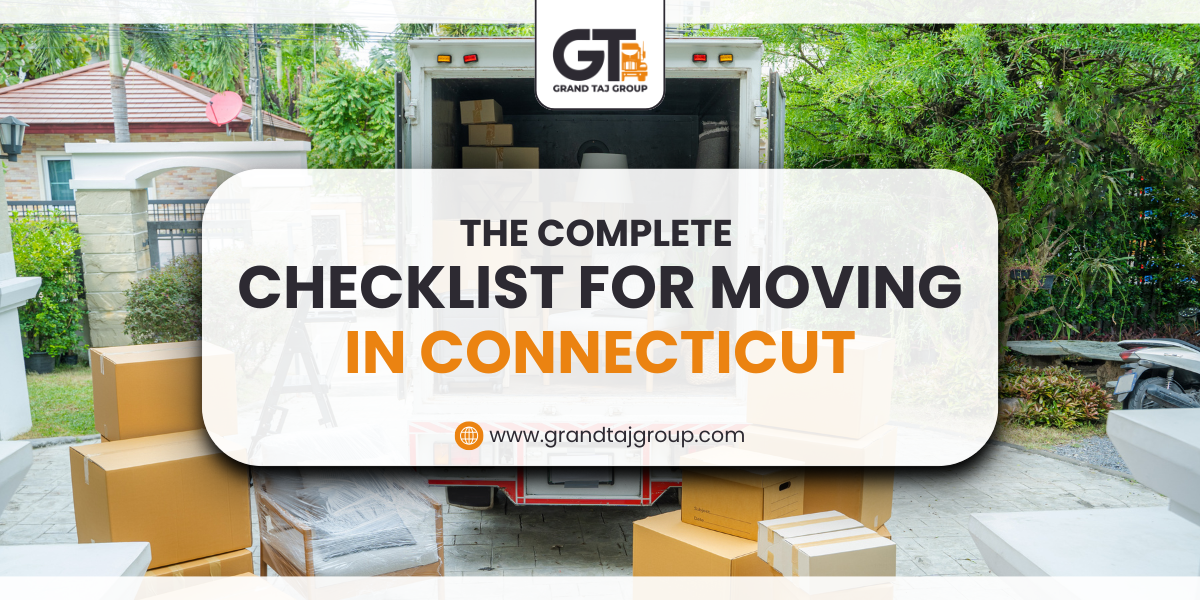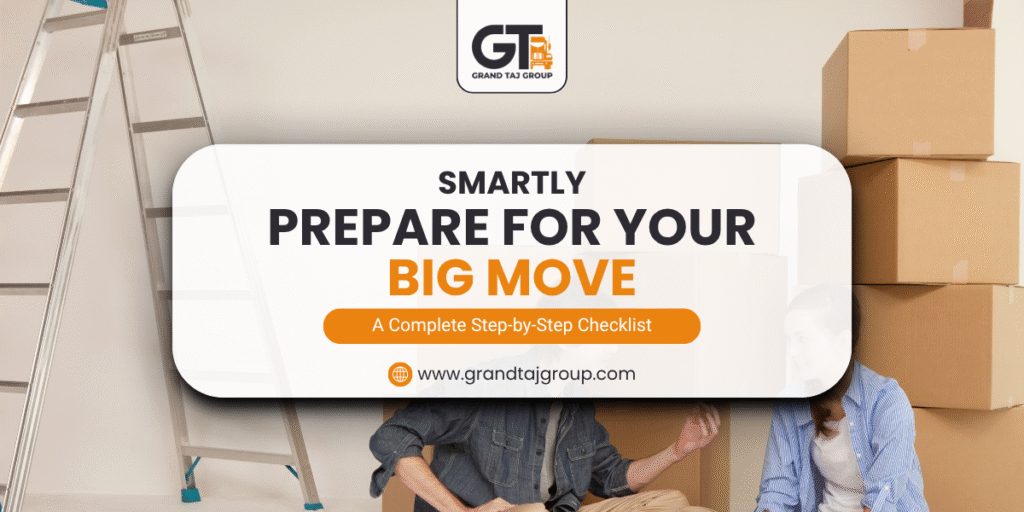You’re sipping your morning coffee, surrounded by half-packed boxes and a growing to-do list. The moving truck is booked, but your mind is racing. What have you forgotten? Whether you’re relocating to the scenic shores of the Connecticut coast or a cozy town inland, moving doesn’t have to be chaotic. With the right checklist, it can be smooth, organized, and even, dare we say, enjoyable.
Checklist for Moving in Connecticut
This complete moving checklist will walk you through every step of your Connecticut move, from planning to settling in. Let’s break it down.
Start Planning Early
The earlier you plan, the smoother your move.
- Set a moving date and notify your landlord (if renting) or begin the selling/buying process.
- Create a moving binder or digital folder to keep everything organized: quotes, receipts, contracts, etc.
- Determine your budget for movers, packing supplies, utility transfers, and unexpected expenses.
- Decide whether you’ll hire professional movers or do it yourself. Book them early, especially in peak seasons (spring/summer).
Declutter and Downsize
Don’t move what you don’t need.
- Go through each room and sort items into keep, donate, sell, or toss.
- Consider hosting a yard sale or listing items on Facebook Marketplace or Craigslist.
- Drop off donations to local centers like Goodwill, Salvation Army, or Connecticut-based shelters.
Having fewer belongings means you’ll spend less on moving costs and save time when unpacking. Decluttering before your move not only lightens the load but also makes the entire process more efficient and less stressful.
Notify Important Parties
Keep everyone in the loop.
- Change your address through USPS (can be done online).
- Notify your bank, credit card companies, insurance providers, and employer.
- Update your driver’s license and vehicle registration with the Connecticut DMV if you’re moving from out of state.
- Inform your doctor, dentist, and vet, and transfer medical records if necessary.
Set Up and Disconnect Utilities
No one wants to move into a cold, dark house.
- Schedule disconnection of utilities at your old place:
- Electricity
- Water
- Gas
- Internet and cable
- Trash pickup
- Schedule setup at your new Connecticut home:
- Connecticut Light and Power (now Eversource) or United Illuminating
- Local internet/cable providers (Optimum, Frontier)
- Water and sewer (contact your town’s utility office)
- Arrange trash pickup and recycling with the new municipality.
Gather Packing Supplies
Start collecting early; supplies add up quickly.
- Boxes (buy or ask local stores for free ones)
- Packing tape
- Bubble wrap or newspaper
- Markers for labeling
- Specialty boxes for TVs, electronics, or dishes
Pro tip: Don’t overpack boxes. Keep them under 50 lbs to avoid injury or breakage.
Organize Your Belongings
Label and inventory like a pro.
- Label boxes with the room name + brief contents.
- Create an inventory spreadsheet or use moving apps like Sortly.
- Pack essentials separately: medications, chargers, toiletries, one set of clothes, important documents, snacks.
- Keep valuable documents (passports, wills, birth certificates) with you.
Finalize Moving Services
Don’t wait till the last minute.
- Confirm booking with your moving company. Reconfirm a few days before the move.
- If you’re renting a truck, check pick-up/drop-off hours and required documents.
- If needed, hire specialty movers for pianos, antiques, or large furniture.
- Arrange for child or pet care during the move to reduce stress.
Clean and Prepare Your Old Home
Leave the old place better than you found it.
- Patch nail holes, repaint walls (if required), and fix minor issues.
- Deep clean the home:
- Vacuum carpets
- Scrub bathrooms and kitchen
- Clean appliances and windows
- Take photos for records (especially if you’re a renter).
Do a Pre-Move Visit (If Possible)
Before moving into your new Connecticut home, it’s a good idea to schedule a pre-move visit so you know exactly what you’re walking into. This walkthrough allows you to take important measurements of doorways, hallways, and staircases to ensure that your furniture will fit smoothly during the move-in process. It also gives you a chance to inspect the condition of the home firsthand.
Check that all smoke detectors are functioning properly and that light fixtures are working in every room. Look around for general cleanliness and be alert for any signs of pest issues, such as droppings or damage. Additionally, locate essential utility controls like the circuit breaker, water shut-off valve, and thermostat.
Knowing where these are in advance can save you valuable time and hassle once you’re fully moved in. A pre-move visit helps you feel more confident and prepared, turning the first day in your new home into a smoother experience.
Moving Day Must-Haves
Keep these close and ready.
- A small bag or box with:
- Snacks and water
- Toiletries and medication
- Phone charger
- Toilet paper and paper towels
- Change of clothes
- Copies of moving contracts and IDs
Don’t forget to walk through your old home one last time to ensure nothing is left behind.
After the Move: Settle In
Follow the following steps
- Unpack your essentials first: kitchen, bathroom, bedding.
- Do a quick cleaning sweep of your new home.
- Check that all utilities are working.
- Recycle moving boxes or donate them.
Explore Your New Connecticut Neighborhood
Once you’ve settled into your new Connecticut home, take some time to get familiar with your surroundings. It can make a big difference in how quickly you feel at home. Start by introducing yourself to your neighbors.
A simple hello can go a long way in building a sense of community and support. Then, explore the essentials in your area. Find out where the nearest grocery stores, post office, pharmacy, and emergency services are located. Knowing these spots in advance will save you time and stress later on, especially in urgent situations.
Beyond the basics, take the opportunity to enjoy what Connecticut has to offer. Whether it’s relaxing at one of the state’s beautiful beaches, hiking along scenic trails, visiting local museums, or discovering hidden gem eateries, there’s no shortage of ways to explore and enjoy your new neighborhood.
Familiarizing yourself with the area not only helps with daily convenience, it also helps you feel truly connected to your new community.
Register and Secure Your New Home
Make your new home official, and safe.
- Register with your local town hall or city office.
- Update voter registration.
- Install a security system or update door locks.
- Get a home warranty (especially if buying a pre-owned home).
Make a Long-Term Checklist
Your move doesn’t end on day one.
- Set a timeline for unpacking room-by-room.
- Update subscriptions (streaming, meal kits, etc.)
- Review your budget and adjust for any new costs (property taxes, utility changes, etc.)
- Schedule a housewarming (if you’re up for it!).
Conclusion
Moving is no small task, but you’ve made it through with planning, patience, and this checklist by your side. Whether you’re drawn to Connecticut’s charming towns, coastline beauty, or school districts, this move is your new beginning. Embrace it fully. You can also hire professional moving services in Connecticut.
So go ahead, light a candle, order your favorite pizza, and toast to your new adventure. You’ve earned it.
Frequently Asked Questions (FAQs)
Q1. What is the best time of year to move in Connecticut?
Ans. The most popular time to move in Connecticut is between late spring and early fall, typically from May to September. During this period, the weather is more predictable and ideal for transporting belongings.
However, it’s also the busiest season for moving companies, so prices can be higher and availability limited. If you’re looking to save money, consider moving during the off-season (late fall or winter), but be prepared for possible weather-related delays.
Q2. How far in advance should I start planning my move?
Ans. Ideally, you should start planning your move at least 6 to 8 weeks in advance. This gives you enough time to create a budget, hire movers, sort through your belongings, and handle logistics like utility transfers and address changes.
Starting early helps you avoid last-minute stress and ensures you don’t overlook any critical steps in the process.
Q3. Do I need to notify the state if I’m moving within Connecticut?
Ans. Yes, if you’re moving within Connecticut, you’ll need to update your address with the DMV for your driver’s license and vehicle registration within 48 hours of your move. Additionally, update your address with USPS, banks, insurance companies, and your employer. Notifying these parties ensures you continue receiving important mail and maintain legal compliance with state regulations.
Q4. How can I make moving with kids or pets easier?
Moving with children or pets can be challenging, but planning ahead helps. Try to maintain their routines as much as possible during the transition. Pack their essentials separately, including favorite toys, snacks, and comfort items.
On moving day, consider arranging for a friend, family member, or sitter to look after them so you can focus on logistics. Once you arrive, introduce them to the new environment gradually and patiently to ease the adjustment.
Q5. What should I do first after moving into my new Connecticut home?
Ans. After moving in, start by unpacking your essentials box, toiletries, bedding, kitchenware, and medications. Check that all utilities (electricity, water, internet, etc.) are working properly.
Walk through your home to ensure everything is clean and in order. Introduce yourself to neighbors, and locate nearby services such as grocery stores and healthcare providers. Taking these initial steps helps you settle in quickly and comfortably.




